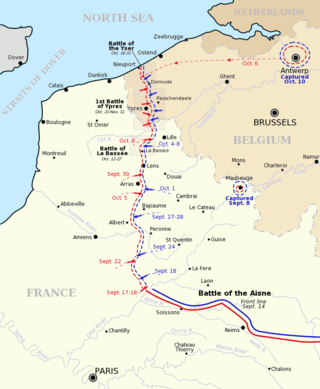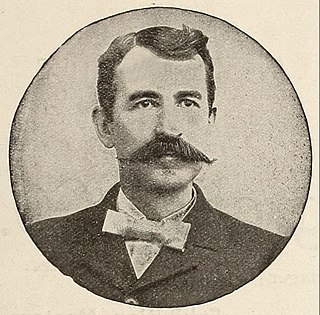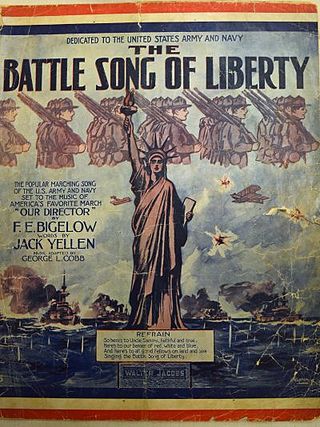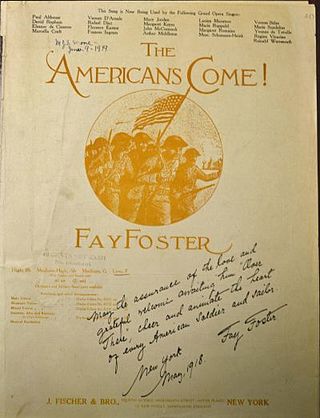Related Research Articles

"Poland Is Not Yet Lost", also known as the "Dąbrowski's Mazurka", and the "Song of the Polish Legions in Italy", is the national anthem of the Republic of Poland.

Yoko Ono is a Japanese multimedia artist, singer, songwriter, and peace activist. Her work also encompasses performance art and filmmaking.


"K-K-K-Katy" is a World War I-era song written by Canadian American composer Geoffrey O'Hara in 1917 and published in 1918. The sheet music advertised it as "The Sensational Stammering Song Success Sung by the Soldiers and Sailors", as well as "The Sensational New Stammering Song" The song was first played at a garden party fund-raiser for the Red Cross in Collins Bay on Lake Ontario. O'Hara was from Chatham, Ontario, and taught music at several universities.

The First Battle of the Aisne was the Allied follow-up offensive against the right wing of the German First Army and the Second Army as they retreated after the First Battle of the Marne earlier in September 1914. The Advance to the Aisne consisted of the Battle of the Marne (7–10 September) and the Battle of the Aisne (12–15 September).

Edward Taylor Paull was a minor American composer, arranger, and sheet music publisher.

Harry S. Miller was an American lyricist, composer, and sometimes playwright who lived in New York and Chicago in the 19th and early 20th centuries and is best known for his song "The Cat Came Back", published in 1893.

During the American Civil War, music played a prominent role on both sides of the conflict, Union and Confederate. On the battlefield, different instruments including bugles, drums, and fifes were played to issue marching orders or sometimes simply to boost the morale of one's fellow soldiers. Singing was also employed not only as a recreational activity but as a release from the inevitable tensions that come with fighting in a war. In camp, music was a diversion away from the bloodshed, helping the soldiers deal with homesickness and boredom. Soldiers of both sides often engaged in recreation with musical instruments, and when the opposing armies were near each other, sometimes the bands from both sides of the conflict played against each other on the night before a battle.

"Say a Prayer for the Boys "Out There"" is a World War I era song released in 1917. Bernie Grossman wrote the lyrics. Alex Marr composed the music. It was published by Joe Morris Music, Co. of New York, New York. The sheet music cover was designed by the Starmer Brothers. It features a family praying at the dinner table. Behind them is a sentry guarding a campground of tents. There is an inset photo on the left side that varies per edition. The song was written for both voice and piano.

"After the War Is Over Will There Be Any 'Home Sweet Home'?" is a World War I–era song released in 1917. Elmer J. Pourmon and Joseph Woodruff wrote the lyrics. Harry Andrieu composed the music. The cover lists Woodruff as composer and Pourmon as lyricist. Contradictory information inside the sheet music lists Harry Andrieu as composer, and Woodruff and Pourmon as lyricists.

"For Your Country and My Country" is a World War I era song released in 1917. Lyrics and music were written by Irving Berlin. The song was published by Waterson, Berlin & Snyder, Co. of New York, New York. Artist Albert Wilfred Barbelle designed the sheet music cover. It features Uncle Sam playing a snare drum with an eagle on his shoulder. In the background are ships sailing, and below are troops marching. Above the title, it reads, "The Official Recruiting Song." The song was written for voice and piano, along with chords for guitar, ukulele, and banjo.
One Sweet Morning is a four-movement song cycle for mezzo-soprano solo and orchestra by the American composer John Corigliano. The work was jointly commissioned by the New York Philharmonic and the Shanghai Symphony Orchestra to commemorate the 10th anniversary of the September 11 attacks. It was given its world premiere on September 30, 2011, by the mezzo-soprano Stephanie Blythe and the New York Philharmonic under the conductor Alan Gilbert. The piece is dedicated to the memory of Natalie and Serge Koussevitzky.
The Pied Piper Fantasy is a concerto for flute and orchestra by the American composer John Corigliano. The work was commissioned by the flutist James Galway and it is based on the tale of the Pied Piper of Hamelin. The piece was given its world premiere by Galway and the Los Angeles Philharmonic under the conductor Myung-whun Chung at the Dorothy Chandler Pavilion on February 4, 1982. In 1993, the critic Mark Swed of the Los Angeles Times described it as "one of the best known of modern American concertos."

The Nation's Call for Humanity and Right is a World War I song written by N.A.W. Carty. It was published in 1918 by N.A.W. Carty in Lawrence, MA. The sheet music cover depicts a sailor and a soldier flanking a civilian holding a flag.

"Oh! Frenchy" is a World War I song written by Sam Ehrlich and composed by Con Conrad. It was published in New York, New York by Broadway Music corporation in 1918. The song was in the top 20 charts from September 1918 to March 1919 and was number 2 in October, December, and February. The sheet music cover features a soldier pictured in uniform with a woman in his heart.
"Lafayette " is a World War I song written and composed by Mary Earl, which was a pseudonym of Robert A. King. It was published in New York, New York by Shapiro, Bernstein, & Co. in 1918. The sheet music cover, illustrated by Albert Barbelle, depicts soldiers marching with fixed bayonets below a statue of Lafayette in silhouette.

"Keep Your Head Down, Fritzie Boy" is a World War I song written and composed by Gitz Rice. This song was published in 1918 by Leo. Feist, Inc., in New York, NY. The cover features a photo of Gitz Rice and reads "inspired by a brave Tommy and written at the Battle of Ypres, 1915."

Let's All Be Americans Now is a World War I song written and composed by Irving Berlin, Edgar Leslie, and George W. Meyer. The song was first published in 1917 by Waterson, Berlin & Snyder Co., in New York, NY.The sheet music cover depicts a soldier with his rifle and silhouetted marching soldiers in the background. A popular recording in 1917 was made by the American Quartet.

The Battle Song of Liberty is a World War I song written by Jack Yellen and composed by George L. Cobb, adapted from "Our Director" by F.E. Bigelow. The song was first published in 1917 by Walter Jacobs, in Boston, Massachusetts. The sheet music cover features the Statue of Liberty amid a sea battle with planes and marching soldiers in the background. It is dedicated to the US Army and Navy.

"The Americans Come " is a World War I song written and composed by Fay Foster. The song was first published in 1918 by J. Fischer & Bro., in New York City. The sheet music cover depicts soldiers marching with a city and battleship on the left and a bombed city on the right.
References
- ↑ Parker, Bernard S. (2007). World War I Sheet Music. Vol. 1. Jefferson: McFarland & Company, Inc. p. 45. ISBN 978-0-7864-2798-7.
- ↑ Battle of the nations: descriptive march. OCLC 53114742 . Retrieved 7 January 2016– via OCLC WorldCat.